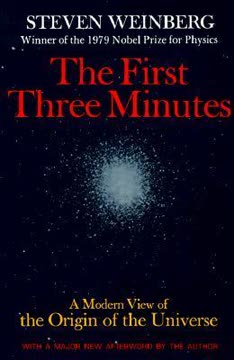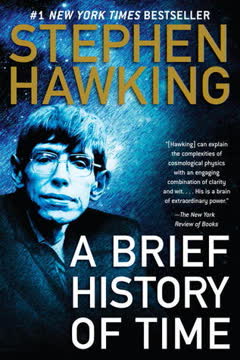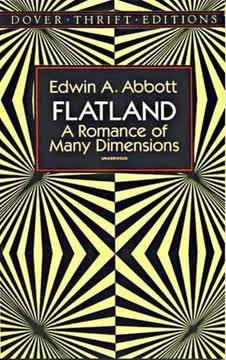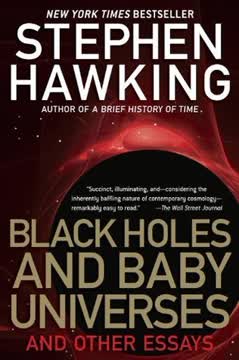Key Takeaways
1. The Science of Interstellar: A Journey Through Space, Time, and Hollywood
"I don't know a good way to draw it, no better way than Figure 23.5. But it has marvelous consequences."
A unique collaboration. The book "The Science of Interstellar" is the result of a remarkable partnership between renowned physicist Kip Thorne and Hollywood filmmakers. It explores the scientific concepts behind Christopher Nolan's film "Interstellar," blending cutting-edge physics with cinematic storytelling.
Scientific accuracy in fiction. Thorne worked closely with the film's creators to ensure scientific accuracy while allowing for creative storytelling. The book delves into the physics of black holes, wormholes, time dilation, and other advanced concepts, explaining how they were incorporated into the film's narrative.
Bridging science and entertainment. This collaboration demonstrates how science can inspire and enrich storytelling, while also using popular media as a vehicle to educate the public about complex scientific ideas.
2. Black Holes: Warped Spacetime and Gravitational Monsters
"Black holes are made from warped space and warped time. Nothing else—no matter whatsoever."
Defining black holes. Black holes are regions of space where gravity is so strong that nothing, not even light, can escape. They are not composed of matter, but are instead made entirely of warped spacetime.
Key characteristics:
- Event horizon: The boundary beyond which nothing can escape
- Singularity: The infinitely dense center of a black hole
- Gravitational time dilation: Time flows more slowly near a black hole
- Gravitational lensing: Black holes bend light, distorting the appearance of objects behind them
Gargantua in Interstellar. The film features a supermassive black hole called Gargantua, which plays a crucial role in the plot. Thorne worked with visual effects artists to create the most scientifically accurate depiction of a black hole ever seen in a feature film.
3. Wormholes: Shortcuts Through the Universe
"A wormhole isn't a naturally occurring phenomenon."
Theoretical constructs. Wormholes are hypothetical tunnels through space-time that could create shortcuts for long journeys across the universe. While allowed by Einstein's equations, they are likely impossible to form naturally.
Key concepts:
- Einstein-Rosen bridges: The mathematical description of wormholes
- Exotic matter: Hypothetical matter with negative energy density, required to keep wormholes open
- Traversability: The potential for matter to pass through a wormhole
In Interstellar. The film uses a wormhole as a plot device to allow interstellar travel. Thorne explores the scientific basis for this concept and the challenges of visualizing a four-dimensional object in a three-dimensional medium.
4. Relativistic Time Dilation: The Profound Effects of Gravity on Time
"Everything likes to live where it will age the most slowly, and gravity pulls it there."
Einstein's insights. Time dilation is a consequence of Einstein's theory of relativity, which states that time flows more slowly in stronger gravitational fields or at higher velocities.
Real-world examples:
- GPS satellites: Must account for time dilation to maintain accuracy
- Atomic clocks: Can measure tiny differences in the flow of time at different altitudes
Extreme time dilation in Interstellar. The film dramatically illustrates this concept with Miller's planet, where one hour on the surface equals seven years on Earth due to its proximity to the supermassive black hole Gargantua.
5. The Fifth Dimension: Exploring the Concept of Bulk
"To Them time may be just another physical dimension. To Them the past might be a canyon they can climb into and the future a mountain they can climb up."
Beyond our observable universe. The concept of "bulk" in the film refers to a higher-dimensional space in which our three-dimensional universe (or "brane") exists.
Key ideas:
- Brane theory: Suggests our universe is a membrane in a higher-dimensional space
- String theory: Proposes the existence of additional spatial dimensions
- Bulk beings: Hypothetical entities that could move freely through these extra dimensions
Implications for the story. In Interstellar, the idea of bulk and higher dimensions is used to explain seemingly impossible feats, such as manipulating gravity across time and space.
6. Gravitational Anomalies and the Quest to "Solve Gravity"
"Newton's third law. The only way humans have ever figured out for getting somewhere is to leave something behind."
Unexplained phenomena. Gravitational anomalies in the film refer to unexplained gravitational effects that don't fit with our current understanding of physics.
The Professor's equation:
- Attempts to unify gravity with quantum mechanics
- Seeks to explain and control gravitational anomalies
- Represents the frontier of theoretical physics
Quest for a theory of everything. The film's plot revolves around the attempt to "solve gravity," which in real physics corresponds to the ongoing search for a theory that unifies general relativity with quantum mechanics.
7. Visualizing the Impossible: Bringing Scientific Accuracy to Film
"It was a joy working with them."
Groundbreaking visuals. Thorne collaborated closely with the visual effects team to create scientifically accurate representations of black holes, wormholes, and other cosmic phenomena.
Innovations:
- First accurate depiction of a black hole's accretion disk in a feature film
- Visualization of gravitational lensing effects around a black hole
- Representation of a four-dimensional tesseract in three-dimensional space
Balancing accuracy and storytelling. While striving for scientific accuracy, certain compromises were made for the sake of the narrative and visual clarity for the audience.
8. The Endurance's Journey: Navigating Extreme Physics
"Cooper makes a quick decision: 'The navigation mainframe's destroyed and we don't have enough life support to make it back to Earth. But we might scrape to Edmunds' planet.'"
Interstellar navigation challenges. The film explores the extreme conditions and physics involved in traveling near a supermassive black hole.
Key concepts:
- Gravitational slingshots: Using gravity to accelerate spacecraft
- Critical orbit: The unstable orbit at the "rim of the volcano" around a black hole
- Extreme time dilation: Dealing with drastically different passage of time in various locations
Balancing realism and drama. The film's depiction of space travel involves both scientifically accurate concepts and dramatic license to create compelling storytelling.
9. Singularities: Where Physics Breaks Down
"A BKL singularity is chaotic. Highly chaotic. And lethal. Highly lethal."
The limits of known physics. Singularities represent points where our current understanding of physics breaks down, typically found at the center of black holes.
Types of singularities:
- BKL (Belinsky-Khalatnikov-Lifshitz): Chaotic singularity at the center of black holes
- Infalling singularity: Created by matter falling into a black hole
- Outflying singularity: A newly discovered type of singularity in rotating black holes
Quantum gravity. The behavior of singularities is thought to be governed by the yet-undiscovered laws of quantum gravity, representing a frontier in theoretical physics.
10. Time Travel and Messaging the Past: Pushing the Boundaries of Physics
"Cooper can move far faster than the flow of time in the bedroom extrusions, so he can easily travel through the tesseract complex to most any bedroom time that he wishes!"
Theoretical possibilities. While backwards time travel is likely impossible, the film explores speculative concepts based on current physics theories.
Key ideas:
- Closed timelike curves: Theoretical paths through spacetime that return to their starting point in space and time
- Gravitational waves: Ripples in spacetime that could potentially carry information
- Bulk beings: Hypothetical entities that could manipulate time and space from higher dimensions
Storytelling with scientific grounding. The film uses these concepts to create a narrative that pushes the boundaries of known physics while maintaining a connection to real scientific theories and speculation.
Last updated:
FAQ
What's The Science of Interstellar about?
- Exploration of scientific concepts: The book delves into the scientific principles behind the film Interstellar, covering topics like black holes, wormholes, and gravitational waves.
- Collaboration with filmmakers: Kip S. Thorne, a renowned physicist, worked closely with director Christopher Nolan to ensure the film's science was both accurate and engaging.
- Accessible to all readers: Thorne aims to make complex scientific ideas understandable to a general audience, encouraging curiosity about the universe.
Why should I read The Science of Interstellar?
- Unique perspective on science: The book offers insights from a leading physicist who contributed to a major Hollywood film, blending entertainment with education.
- Inspires interest in science: Thorne's passion for science is infectious, motivating readers to explore scientific concepts and their implications for humanity.
- Deepens understanding of the film: Readers gain a richer appreciation of Interstellar by learning the real science behind its plot and visuals.
What are the key takeaways of The Science of Interstellar?
- Understanding black holes: The book explains how black holes are formed, their properties, and their role in the universe, emphasizing their nature as "warped space and warped time."
- Concept of wormholes: Thorne discusses the theoretical existence of wormholes, their potential for interstellar travel, and the need for "exotic matter" to keep them open.
- Impact of gravity on time: The relationship between gravity and time is explored, particularly how "time slows near Gargantua," affecting the characters' experiences in the film.
What are the best quotes from The Science of Interstellar and what do they mean?
- "Accident is the first building block of evolution.": This quote reflects the unpredictability of life and evolution, suggesting that chance events can lead to significant changes in species and environments.
- "A wormhole isn’t a naturally occurring phenomenon.": Thorne emphasizes that traversable wormholes, if they exist, are likely artificial constructs rather than naturally occurring entities in the universe.
- "The last people to starve will be the first to suffocate.": This quote highlights the dire consequences of environmental collapse, illustrating the interconnectedness of food supply and breathable air in a deteriorating ecosystem.
How does The Science of Interstellar explain black holes?
- Black holes as warping spacetime: Thorne describes black holes as regions where spacetime is warped so severely that nothing, not even light, can escape their gravitational pull.
- Gargantua's properties: The book details the characteristics of Gargantua, the black hole in Interstellar, including its mass, spin, and the effects of its tidal gravity on nearby objects.
- Visualizing black holes: Thorne discusses how the film visually represents black holes and their accretion disks, using scientific principles to create a realistic portrayal.
What scientific principles are explained in The Science of Interstellar?
- Black holes and their properties: The book details how black holes warp space and time, affecting nearby objects and light, and discusses their formation from dying stars.
- Wormholes as shortcuts: Thorne explains the concept of wormholes as theoretical passages through space-time that could allow for faster-than-light travel, contingent on the existence of exotic matter.
- Gravitational waves: The text covers the detection of gravitational waves and their significance in understanding cosmic events, such as black hole collisions.
How does The Science of Interstellar address the concept of time?
- Time as a fourth dimension: Thorne emphasizes that time is treated as a fourth dimension in the universe, fundamentally different from the three spatial dimensions we experience.
- Time dilation near black holes: The book explains how time slows down in strong gravitational fields, such as those near black holes, affecting the experiences of characters in the film.
- Interplay of time and gravity: Thorne discusses how gravity influences the flow of time, a key theme in both the film and the scientific principles it explores.
What is the significance of gravitational anomalies in The Science of Interstellar?
- Key to understanding gravity: Gravitational anomalies are presented as phenomena that could provide insights into the fundamental nature of gravity and its effects on space-time.
- Potential for new discoveries: Thorne suggests that studying these anomalies could lead to breakthroughs in our understanding of the universe and the laws of physics.
- Plot device in the film: In Interstellar, these anomalies drive the narrative, influencing the characters' decisions and the quest for survival.
How does The Science of Interstellar explain the role of gravity?
- Gravity as a fundamental force: Thorne emphasizes that gravity is one of the four fundamental forces of nature, governing the interactions of matter and the structure of the universe.
- Gravitational waves: The book discusses the significance of gravitational waves, ripples in spacetime caused by massive objects, and their role in the film's narrative and scientific foundation.
- Harnessing gravity for survival: Thorne explores the idea that understanding and manipulating gravity could be key to humanity's survival, a central theme in Interstellar.
What is the significance of the tesseract in The Science of Interstellar?
- Representation of higher dimensions: The tesseract symbolizes a four-dimensional space that allows Cooper to interact with different moments in time, showcasing the film's exploration of time as a physical dimension.
- Communication across time: Inside the tesseract, Cooper can send gravitational signals to his daughter Murph, illustrating the book's theme of using scientific principles to transcend traditional limitations of time.
- Complexity of the tesseract: Thorne explains how the tesseract is not just a simple hypercube but is modified to enhance the narrative, allowing for a rich visual and conceptual experience.
What challenges did Kip Thorne face while writing The Science of Interstellar?
- Balancing science and storytelling: Thorne had to ensure that complex scientific ideas were presented in an engaging way that would resonate with a general audience.
- Collaborating with filmmakers: He navigated the creative process with directors and screenwriters, balancing scientific integrity with the demands of cinematic storytelling.
- Explaining advanced concepts: Thorne aimed to make difficult topics like quantum gravity and relativistic physics accessible, which required careful thought and clear explanations.
What role does Kip Thorne hope The Science of Interstellar will play for readers?
- Encouraging scientific curiosity: Thorne aims to inspire readers to explore scientific concepts and engage with the wonders of the universe.
- Bridging science and fiction: The book serves as a bridge between the realms of science and storytelling, demonstrating how scientific principles can inform and enhance narrative experiences.
- Educating the public: Thorne hopes to make complex scientific ideas accessible, fostering a greater understanding of the universe and the importance of scientific inquiry.
Review Summary
The Science of Interstellar receives mostly positive reviews, praised for its accessible explanations of complex physics concepts related to the film. Readers appreciate Thorne's clarity in distinguishing between established science, educated guesses, and speculation. Many find the book enhances their understanding and appreciation of the movie. Some readers struggle with the more technical sections, but overall, the book is commended for its scientific rigor and engaging content. Several reviewers note that it changed their perspective on the film and sparked greater curiosity about the universe.
Similar Books
Download PDF
Download EPUB
.epub digital book format is ideal for reading ebooks on phones, tablets, and e-readers.










